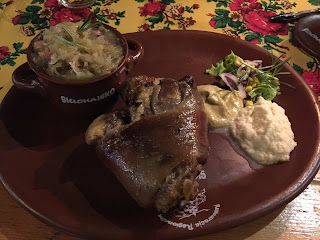As you can probably tell, we have loved our road trip around Poland. We have been blessed with glorious weather, and our original intention of “seeing Eastern Europe in the spring” proved right. The blog posts have covered the churches, castles, mountains and forests. But what is it actually like to travel in Poland - which is for some unknown reason a comparatively rare destination for Brits.
People
We haven’t really met or got to know any Poles in detail, but those we have interacted with at cafes, hotels, shops etc have all been totally charming. And staggeringly most speak enough English so that we could get what we needed (with a little help from Google Translate!). Which is lucky, because the language is utterly indecipherable - with the abundance of z, c and L (pronounced “w”). We thought we had mastered “hello” cześć and “thank you” Dziękuję Ci, but the pronunciation changed as we headed north, causing much amusement.

History
I’m not about to bore you with a Polish history lesson. But what is abundantly evident as we travelled through the country is the turbulent times it has experienced in the last 500 years - with multiple ‘owners’, wars, repeat restoration and destruction, and of course the annihilation of 90% of the Polish Jewish population during WWII. However, all the major attractions we visited have been lovingly restored and the cities of Krakow and Gdansk are a delight to simply wander around.
Green & yellow
The majority of our route south from Krakow and then ‘up’ the eastern provinces to Gdansk was a vibrant, energising green colour - with spring woodland, extensive crops (both small tenement and large scale agriculture) - plus swathes of oilseed rape and extensive dandelions!!
Roads
This was after all a road trip; so what are the roads like? I had considered bringing my go-faster Golf and even checked a forum for guidance (sad but true); the advice was don’t on the grounds of bad road conditions and crazy drivers. The soggy hire car suspension was certainly better suited to the roads, which are quite bumpy (there are super smooth motorways too) - but there are way less potholes than Kent! And we only saw a couple of examples of the legendary Polish overtaking. Beautiful scenery, uncrowned and great signs; our favourite was probably the “strutting cow”:

Storks
Every village we drove through had at least one occupied stork’s nest, usually on man made metal supports atop telegraph poles. Apparently they bring good luck to the village, and perhaps all the watery ditches and ponds, plus lack of pesticides & fertiliser, means an abundance of frogs = stork food?! (Thanks Baranaby for that theory!!).
Cemeteries
There are vast cemeteries in every village, but the surprise was the fact that every headstone has fresh flowers - which seem to be replaced every weekend.
Wood
Almost every house in the countryside, and many in the towns too, have amazing woodpiles.
Wood is clearly still a primary fuel source.
And finally, Food!
Everyone has asked us what was the food like - expecting the answer to be "boring". Not the case! Polish food is an adventure, not least because most of it we had never come across. From pierogi (delicious ravioli-esque dumplings with a variety of fillings) to bigos, stuffed cabbage leaves to potato pancakes with goulash, and lots of herring, and cakes! When you have been stomping up and down mountains, it's hard to beat a dinner of black pudding, mashed potato, sauerkraut and a large beer! And of course every restaurant has a selection of at least a dozen vodkas, from bison grass to quince flavour.
 |
| Meatballs |
 |
| It's normal practice to pour hot water on ground coffee in a mug! Filthy |
 |
| Pig knuckle, sauerkraut and horseradish sauce |
 |
| Black pudding! |
 |
| Cabbage leaves stuffed with mince |
 |
| Pierogi |








Or to paraphrase Monty Python - what have the Poles ever done for us?
ReplyDelete